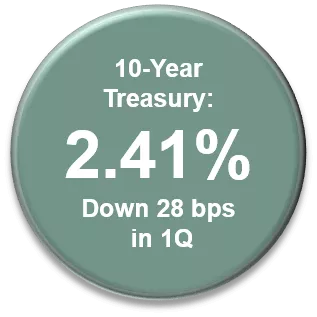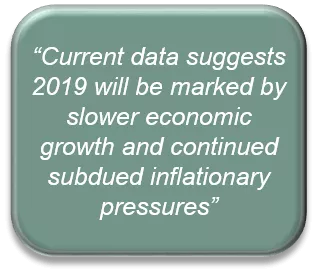Economic Commentary on March 2019 Employment Report

Chief Economist
Pohlad Companies
The first quarter of 2019 delivered a mix of data with all reports back on their scheduled release dates since the government shutdown ended.
Specifically, public equity markets in the U.S. were up 14% after declining a similar amount in the fourth quarter of 2018. Most U.S. equity indices are nearly back to their levels seen at the end of 3Q-18.

The 10-year Treasury bond yield fell 28 basis points during the quarter and ended at 2.41%. As recently as the first of November 2018, 10-year yields were at 3.25%. A slowing economy with continued subdued inflationary pressures is keeping downward pressure on yields.
Of particular interest to investors and businessmen was the announcement by Fed Chairman Powell that they are putting any further interest rate increases on hold in acknowledgement of recent soft economic data. Additionally, he said that the reduction of the Fed’s balance sheet will end in September and that, starting in October, the Fed will purchase up to $20 billion of U.S. Treasury securities per month with principal payments received from agency debt they hold – the reinstatement of quasi-Quantitative Easing.
The Fed is likely to remain on hold until they see deterioration in the labor market (justifying a cut in interest rates), or a more persistent acceleration in inflationary pressures (justifying an increase in interest rates). The current accommodative monetary policy will be offset by the fading impact of the 2017 tax cuts, ongoing trade tensions, and cooling of global economic growth.
Other central banks around the world have taken a cue from the Fed and are indicating more neutral monetary policies, as well.
The March employment report released April 5 showed an addition to nonfarm payrolls of 196,000 vs. estimates of 177,000. This was a nice rebound from the weak advance of 33,000 in February (revised up from 20,000). The unemployment rate stayed steady at 3.8%. Wage gains remain muted, coming in at 3.2% year over year, below estimates of 3.4%. The market is viewing this as another “goldilocks” report for the economy; strong enough to allay concerns that the employment picture is weakening but not too strong to push the Fed to take their finger off the pause button.
The economy experienced another first-quarter soft patch (something we’ve seen in four of the past five years) with real GDP expected to be 1.5%, down from the 2.2% annualized rate recorded in 4Q-18. Economic activity is expected to improve in the remainder of the year from the 1Q-19 slowdown, but for the year 2019, real GDP is expected to slow to 2.4% from the 3.0% growth rate in 2018.

To sum up, current data suggests that 2019 will be marked by slower economic growth (both domestically and globally) and continued subdued inflationary pressures with interest rates remaining lower for longer than expected as recently as the fourth quarter of 2018.
The big question is whether the change in monetary policy by the Fed will result in a rarely seen soft landing, enabling the economic expansion to continue, or if the increase in rates that occurred in 2018 tightened credit conditions enough to push the economy into a recession sometime in the next 12 to 18 months. Given that the effects of monetary policy work with a lag of one to two years, an ongoing review of current economic indicators is especially warranted.
Insights
Research to help you make knowledgeable investment decisions